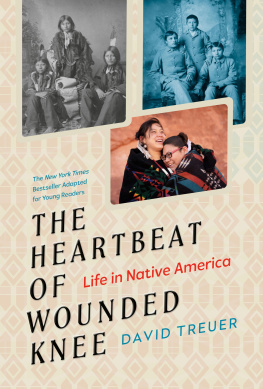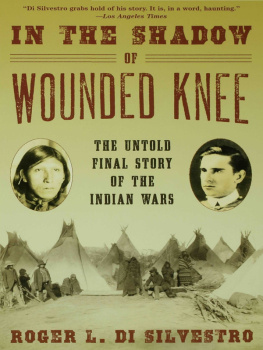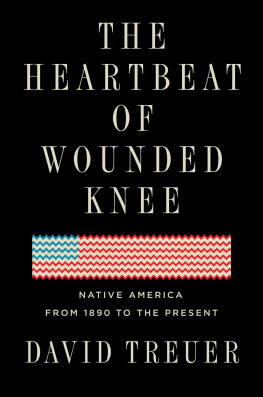Table of Contents

Praise for In the Shadow of Wounded Knee "Di Silvestro grabs hold of his story. It is, in a word, haunting. Its supernatural elements arrive with the ghost dance, a mystical religion that swept Native Americans near the end of the 19th centurywith tragic consequences. An amalgam of Christian and native religious elements, the ghost danceactually a series of dances accompanied by ceremonial cleansing, meditation and prayerexcited white settlers with fear while giving the Indians a tragic sense of invulnerability. They came to believe that under the power of the ghost dance, their shirts could stop white men's bullets.
"That the shirts had no such power the Indians learned to their sorrow and a white nation to its shame and outrage when, on Dec. 29, 1890, the U.S. 7th Cavalry herded about 300 Indians in the cold and the snow of their pathetically poor South Dakota reservation and demanded their guns. One Indian shouted, 'No'; a shot, fired by which side no one knows, rang out. Firing commenced and continued for four hours. By the end of it, at least 150 men, women and children lay dead along the creek.
"Afterward, much of the fear and hatred of the Indian, which began in the late 16th century in New England, had disappeared from the standard American repertory of emotions, replaced by pity and shame. So it was that in a chance encounter on Jan. 7, 1891, when a young Lakota warrior fatally shot a West Point soldier from New England in the back of the head at close range, white public opinion no longer automatically took the white man's side.
"Plenty Horses was arrested in the murder of Lt. Edward Casey, but... This grave and civilized verdict was not, probably, what devotees of the Western myth as present on a thousand movie screens might have expected, but it was a sign of the political and emotional maturing of the American republic at that stage in its growth... Di Silvestro's story is encouraging to a student of the American character. Deep prejudices canand have beenovercome."
Los Angeles Times
"If you don't have any other book on Native America on your bookshelf, get this book. It's full of truth. It's going to tell you a lot of things that you don't know, a lot of things that have been kept hidden from all of you since 1890, since the massacre at Wounded Knee."
Jay Winter Night Wolf, The Night Wolf Show
"A dispassionate encapsulation of the Wild West just before it devolved into myth."
Kirkus Reviews
"In the Shadow of Wounded Knee tells a little of who we were as a nation, and how that nation dealt with the civic virtue of justice, not to mention truth... Di Silvestro has done a remarkable job."
Decatur Daily
"Di Silvestro is particularly adept in his descriptions of the fissures within the various Lakota bands that were exacerbated by the strains of constant white encroachment on their lands. Di Silvestro also provides interesting biographical sketches of Casey and Plenty Horses, which elevates their eventual confrontation to the level of inevitable tragedy."
Library Journal
"This first account of these cases is an eye opener, necessary in knowing where America has come from, and where it is going."
Indian Life
"Readers new to the subject will find Di Silvestro's clear explanation helpful, the violent encounters dramatic and the trials absorbing."
Publishers Weekly
IN THE SHADOW OF
Wounded Knee
IN THE SHADOW OF
Wounded Knee

The Untold Final Chapter of the Indian Wars
ROGER L. DI SILVESTRO

Copyright 2007 by Roger Di Silvestro
All rights reserved. No part of this book may be used or reproduced in any manner whatsoever without written permission from the publisher except in the case of brief quotations embodied in critical articles or reviews. For information address Walker & Company, 104 Fifth Avenue, New York, New York 10011.
Map is from Red Cloud: Warrior-Statesman of the Lakota Sioux, by Robert W Larson. Copyright 1997 by the University of Oklahoma Press, Norman.
Reprinted by permission of the publisher. All rights reserved.
Map is from The Last Days of the Sioux Nation by Robert M. Utley. Copyright 1963 by Yale University Press. The map may not be reproduced, in whole or in part, in any form (beyond that copying permitted by Sections 107 and 108 of the U.S. Copyright Law and except by reviewers for the public press) without written permission of Yale University Press.
Published by Walker Publishing Company, Inc., New York
Distributed to the trade by Holtzbrinck Publishers
All papers used by Walker & Company are natural, recyclable products made from wood grown in well-managed forests. The manufacturing processes conform to the environmental regulations ofthe country of origin.
The Library of Congress has cataloged the hardcover edition as follows:
Di Silvestro, Roger L.
In the shadow of Wounded Knee : the untold story of the Indian Wars / Roger L. DiSilvestro.
p. cm.
eISBN: 978-0-802-71838-9
1. Wounded Knee Massacre, S.D., 1890. 2. Dakota IndiansWars, 1890-1891. I. Title.
E83.89.D57 2005
973.8'6dc22
2005044264
First published in the United States by Walker & Company in 2005
This paperback edition published 2007
Designed by Maura Fadden Rosenthal/Mspace
Typeset by Westchester Book Group
Printed in the United States of America by Quebecor World Fairfield
Visit Walker & Company's Web site at www.walkerbooks.com
1 3 5 7 9 10 8 6 4 2
For Jeanne
With appreciation for your confidence in my writing and for your uncomplaining toleration of my absences, moods, and obsessions, including the buffalo skull under my desk.
CONTENTS
THESE ACKNOWLEDGMENTS REPRESENT SLIM THANKS to only a handful of the people to whom I am indebted for their help and support.
The staff of the archives of Historic New England, which was called the Society for the Preservation of New England Antiquities when I visited its Boston headquarters, won my deep appreciation and respect when they let me extend my time there beyond the restricted visiting hours. Their collection of material from Edward Casey's family, and their kindness in providing it to me, was invaluable.
Also helpful in giving me access to the Casey family home near Newport, Rhode Island, was the staff of the Casey-farm historic site. It's such a beautiful place that it is hard to believe that Edward Casey did not want to spend his life there.
I owe special thanks to Theresa Norman, registrar of the Siouxland Heritage Museums, who let me examine the rifle Plenty Horses used to kill Lieutenant Casey, now stored at the Courthouse Museum in Sioux Falls, South Dakota. Ms. Norman also was patient in dealing with my many queries and provided important research materials to me over the course of the final two years of research and writing.
I also thank John McCabe of the Springfield Armory National Historic Site in Springfield, Massachusetts, who offered information on the type of rifle Plenty Horses used to kill Lieutenant Casey.
My appreciation is deeply felt for the staffs of the various public libraries that helped me with great patience as I rummaged through their archival material. These include the libraries at the Pine Ridge Lakota Reservation; Miles City, Montana; and Sturgis, Sioux Falls, and Rapid City, South Dakota, as well as the archival staff at the Philadelphia Historic Society, which houses the records of the Indian Rights Association.
Next page








